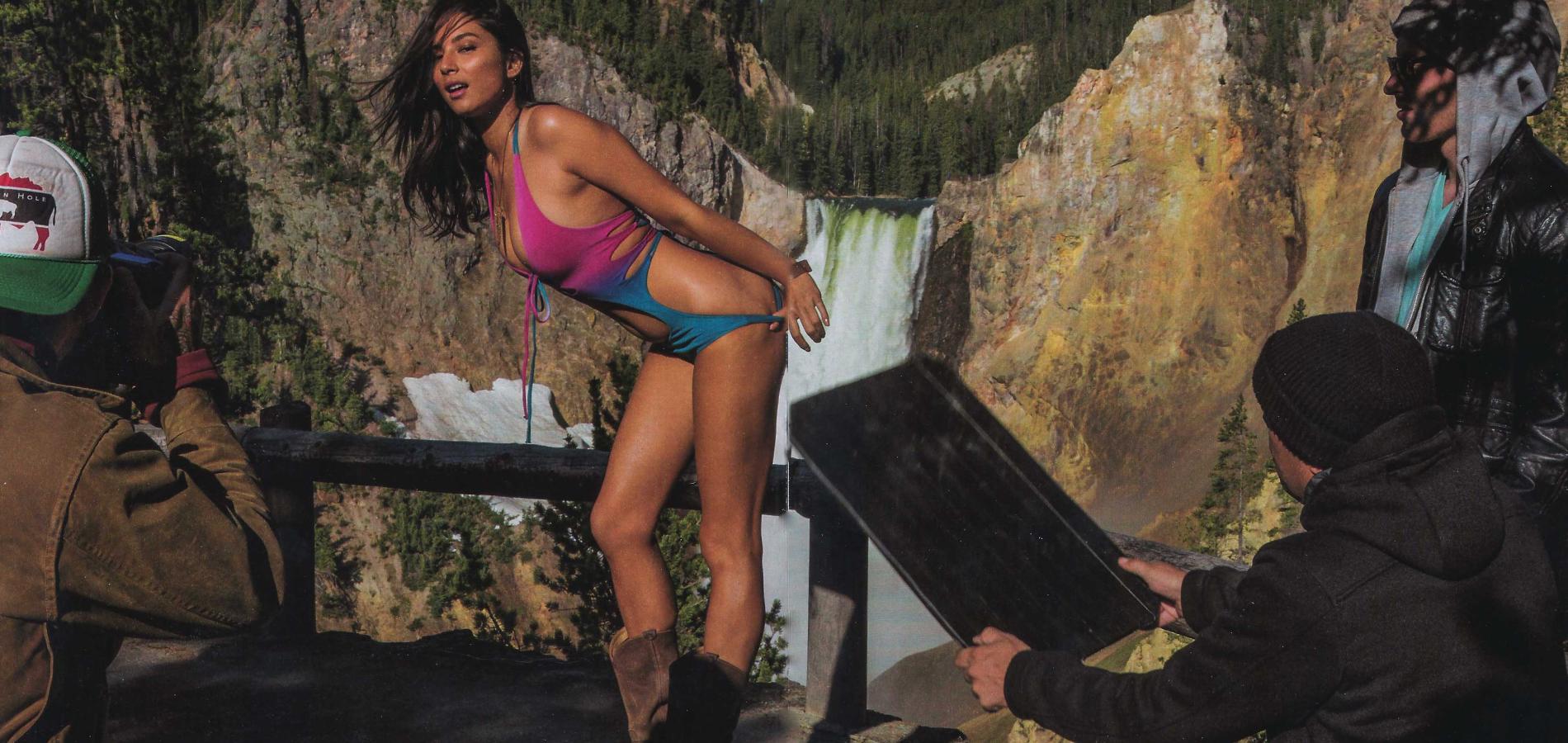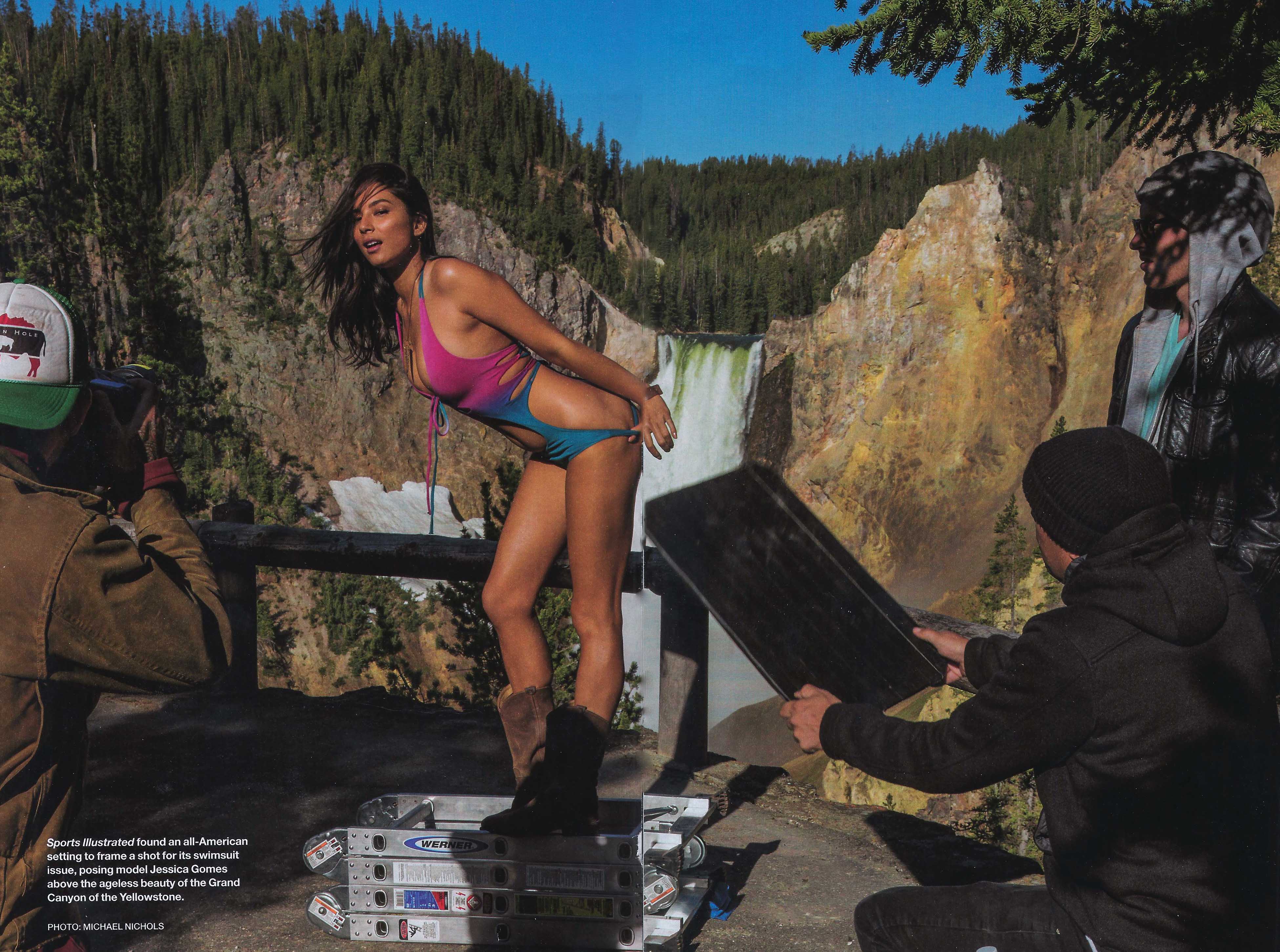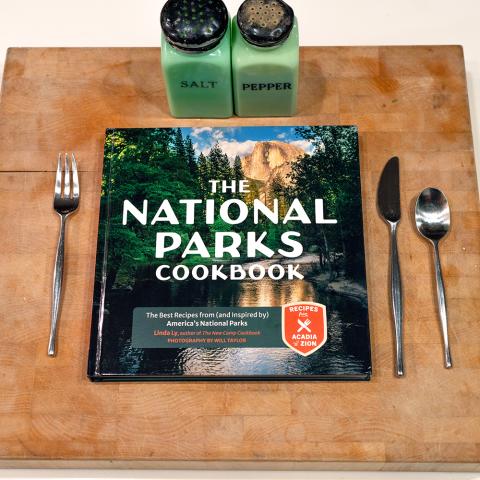For many young adolescent boys growing up in the 1960s, the cold winds, ice, and snows of winter met a thaw in February, when a softer, not quite so lusty version of Playboy showed up in mailboxes across the country: Sports Illustrated's annual Swimsuit Issue.
With bikini-clad models such as Elle Macpherson, Christie Brinkley, Cheryl Tiegs and Rachel Hunter gracing covers and multiple-page spreads within the covers, the Swimsuit Issue quickly became a marketing success. By 2005 it was estimated that that issue alone generated $35 million in revenue for Sports Illustrated. As the years passed, the editors and art directors have gotten more and more risque, dressing their models in skimpier and skimpier swimsuits, and finally painting suits on them.
In 2002, a representative for the National Organization for Women said the issue, "promotes the harmful and dehumanizing concept that women are a product for male consumption."
Until recently, national parks have been left out of the Swimsuit Issue, and generally have been promoted by media as wonderful family destinations. But in 2014 the sports magazine requested, and received permission, to shoot in Yellowstone, Grand Teton and Bryce Canyon national parks for its 2015 Swimsuit Issue.
An outtake from the Yellowstone shoot (above) was used by National Geographic this year in its May issue, which was dedicated to Yellowstone.
Now, as the Park Service is confronting an issue of sexual harassment and misconduct within its workforce, a watchdog group is questioning whether the agency's decision to permit the pictorials doesn't "undermine" its commitment to root out an institutional "culture of tolerance for sexual harassment." In addition, the Park Service's approval of the photo shoots illuminates the gray area in interpreting the agency's management guidelines and recalls a magazine shoot four decades ago that a former park ranger deemed "extremely offensive."
Back in August 1977 Grand Canyon National Park made a splash in Playboy in a river trip pictorial that raised more than a few eyes, as Roderick Nash noted in Wilderness and the American Mind while discussing the issue of river trip permit allocations:
The Grand Canyon allocation controversy raised the deeper question of what kind of use is most appropriate in a federal managed wilderness. One point of view regarded the large, motorized commercial trips as little more than outdoor parties. Beach volleyball and cold beer highlighted these trips. The customers neither expected nor wanted a wilderness experience. The whitewater rapids might as well have been located in an urban amusement park. The highly publicizied and much photographed river trip that Playboy staged came to represent the problem in many minds. The fact that this kind of Grand Canyon trip used part of the limited visitor quota, and in effect kept wilderness enthusiasts off the river, rubbed salt in the already tender wounds of noncommercial boaters.
Grand Canyon resurfaced early this year in another sexually charged saga; not based on titillation, but rather sexual harassment and misconduct. An Office of Inspector General report given to the National Park Service last year and released to the public in January detailed a 15-year-long chapter of sordid behavior in the park's River District. In the end, the park superintendent retired and the Park Service recommitted itself to root out sexual misconduct and harassment, promising to set up a hotline to which complaints could be voiced, anonymously if desired, and to conduct a service-wide survey to determine how prevalent the problem might be.
Last last month, Interior Secretary Sally Jewell traveled to the Grand Canyon with Park Service Director Jon Jarvis, Intermountain Region Director Sue Masica and incoming Grand Canyon Superintendent Chris Lehnertz to meet with the park's employees, hear their concerns, and discuss how the matter would be addressed.
“That’s unacceptable behavior. It is a failure of leadership. It is something that we have got to address," Secretary Jewell told a small pool of reporters gathered at Hopi Point on the South Rim after meeting with roughly 300 park employees. "I will say that this is a team of employees that wants to move on, that does not want to be defined by the actions of a few."
Objectification, Art, Or Freedom Of The Press?
Ironically, as the National Park Service tries to determine just how extensive sexual harassment and misconduct might be across its workforce of 20,000, questions about the appropriateness of Sports Illustrated's use of national parks in 2015 to show off scantily clad models have surfaced. Not only did the sports magazine stage photo shoots in Bryce Canyon, Grand Teton, and Yellowstone national parks, at least, but it also produced videos of the models and crews at work in the parks.

Model Jessica Gomes posed in various locations in Yellowstone for the Sports Illustrated shoot.
Some Park Service employees were disturbed by the Lower Falls image that appeared in National Geographic's May 2016 issue.
"Many permanent and seasonal NPS employees (male & female) object to this image, and the message communicated. It could be inferred by Dan Wenk in NPS uniform (elsewhere in the issue) as NPS endorsing or sanctioning this type of behavior," one employee told the Traveler. "At the very least, if NPS says it had no control over what Nat Geo publishes, I believe the powers that be at National Geographic AND the National Park Service would be singing a different tune if it had been Dan Wenk in his underwear instead of his carefully planned and orchestrated NPS Class A dress uniform on the preceding pages."
At National Geographic, Director of Communications Anna Kukelhaus pointed out that the swimsuit photograph was just one of 70 images of Yellowstone contained in the issue.
"As a journalistic publication, we tell multiple aspects of a story. For our Yellowstone issue, we did not want to just showcase the natural and ageless beauty of the park, but to look at how the park is used and how people interact with it," she said. "We think this image represents one of the ways the park is used. It is also important to note that any photo shoot in a national park cannot take place without park permission. Park rangers accompanied the teams to various locations throughout the park during the course of this shoot."
Concern about the propriety of the photo shoots, in light of the ongoing issue with sexual harassment and misconduct in the Park Service, led Public Employees for Environmental Responsibility to file a Freedom of Information Act request with the Park Service for:
* All permits issued by NPS to Sports Illsutrated or its employees to conduct a photo shoot or photo shoots on NPS land;
* All records indicating where each Sports Illustrated photo shoot took place, including any NPS staff briefings;
* All correspondence between NPS and Sports Illustrated or its employees regarding photo shoots and/or the publication of photos;
* All correspondence between NPS and Nat Geo or its employees regarding the publication of the Jessica Gomes photo in the magazine’s May 2016 issue.
"We are interested in the records for several reasons," PEER's legal counsel, Laura Dumais, told the Traveler. "First, Jon Jarvis and NPS leadership are currently under fire for fostering a long-term culture of tolerance for sexual harassment, where perpetrators enjoy protection while victims fear to report wrongdoing. If it is true that NPS managers found nothing inappropriate about authorizing the publication of a photo of three fully-clothed men literally in the process of objectifying a near-naked woman in front of an iconic Yellowstone waterfall, then it’s not difficult to understand why NPS has a problem."
In its FOIA request, PEER stated that, "If, in fact, NPS condoned the actions of Sports Illustrated and National Geographic in taking/publishing photos that undermine NPS’s stated commitment to ending sexual harassment in national parks, then this is very important information that the public should know about prior to the centennial celebration. Presented with such information, the public may choose not to attend such celebrations, or individuals may choose to exercise their First Amendment rights to engage in informed public discourse on the issue prior to or during the celebration."
Secretary Jewell's office did not respond to a Traveler request for comment on the appropriateness of using national parks as backdrops for the Swimsuit Issue that, after it's arrival, drew harsh criticism for its cover photo being "100 percent inappropriate" and "obscene," along with more graphic descriptions. The National Center on Sexual Exploitation was so shocked by the covergirl on the 2015 issue that the executive director sent letters to retailers asking that the magazine be removed from public display.
At the Park Service's Washington, D.C., headquarters Tom Crosson, chief of public affairs, would not comment on the appropriateness of the photo shoots or whether the agency approved of the images and videos.
"The National Park Service is obligated to protect the public’s right to free speech in national parks, as guaranteed by the First Amendment. We do not apply a 'morals test' when granting access to our parks for legal activities," he said. "When issuing permits, we do consider factors such as the potential impact to park resources and visitor use. If it is determined that a particular activity would constitute impairment to the park and its resources, or would generate unacceptable impacts as defined by NPS Management Policies, or is prohibited by law, the park would deny the request."
Does Sports Illustrated's Swimsuit Issue Uphold National Park "Values"
The management handbook for national park superintendents, the 2006 Management Policies, contains a section on "Appropriate Uses" of the parks. In that section on page 98, the narrative specifies that, "In exercising its discretionary authority, the Service will allow only uses that are (1) appropriate to the purpose for which the park was established... (emphasis added).
Under the Code of Federal Regulations that discretion was trimmed somewhat, removing the wording pertaining to the purpose for why a national park was established. It does, however, state that permits can be denied if the activity results "in unacceptable impacts or impairment to National Park Service resources or values...'" (emphasis added)

Sports Illustrated's crews and model also visited Bryce Canyon National Park for the 2015 issue.
Mr. Crosson would not respond directly to whether the swimsuit photo shoots were appropriate to the purpose for which Yellowstone, Grand Teton, or Bryce Canyon were established, or whether they diminished the values of the parks.
At Yellowstone, Superintendent Wenk said his staff followed guidelines for issuing commerical photography permits when approached by Sports Illustrated.
"Because the project met the legal requirements for this type of permit, specifically that there were no resource or unacceptable impacts to visitor use, we issued the permit," he said in an email.
The guidelines set down by the Management Policies can be difficult to interpret, said Superintendent Wenk.
"We looked at this permit process objectively in 2014. Perhaps we would look at it differently today," he wrote, adding that through the years he has been told "content could not be a reason for denial of a permit as long as other conditions were met."
"The application of NPS policy that you cited can be interpreted many ways," he continued. "What purpose are you saying is not appropriate to the purpose for which the park was established? If you apply your definition, would advertisements for cars, outdoor gear, swimsuits, pain relief or insurance be appropriate? Where do you draw the line if a manufacturer wanted to advertise kayaks and the model wore a swimsuit that was as revealing as the SI model, appropriate or not?"
At the Coalition To Protect America's National Parks, some members thought the swimsuit permit request should have been denied.
"I don’t see that photos/videos of scantily-clad women in any way is consistent with park values. Moreover, I don’t see how this kind of photography or videography for commercial purposes in the public marketplace is considered freedom of the press or speech under the First Amendment," said Bill Wade, whose 30-year NPS career included the Department of the Interior Meritorious Service Award. "I’m sure the (Interior) solicitors – with much more knowledge of the legalities than I have – reviewed all this and approved it, but it seems to me to be a big stretch. One more example of how the policies and laws are gradually becoming more diluted, at the detriment of what national parks stand for."
Added Rick Smith, whose Park Service career included a stint as acting-superintendent at Yellowstone: "Park values are being degraded with this kind of activity. It reminds me of the Playboy shoot on the Colorado River through Grand Canyon, topless models and all. It was extremely offensive."






 Support Essential Coverage of Essential Places
Support Essential Coverage of Essential Places







Comments
Nice response Alfred, the issue however was the SI article and the loosening of the commercialization standards in our National Parks. I felt your response, as much as I agree with most of it, was not on subject, I understand it is difficult to discuss some of the issues without bringing in the political realities. The NPS Directors Office has seriously diminished the standards for "events" such as the SI shoot, I am very much opposed to these new policies and feel it is a poor reflection on the current leadership of the National Park Service.
That would be nice, Rick, but consider this: http://www.eenews.net/stories/1060037104
We need to stay alert because there are real threats out there.
Understood, Lee, but I don't think they should take pictures for "Killing Endangered Species Monthly" in the parks either.
Mr. Runte, "facts"?! Or sheer speculation? Please point us to a clear policy statement by Mr. Trump on National Parks, public lands, conservation or natural resource issues. I am unable to find one.
On topic, Donald Trump Jr., who appears to be speaking for his father's campaign as its "Secretary of Interior", favors increased corporate sponsorships of National Parks. However, Trump has not yet stated whether he rates the SI models as "10s".
More embarrassment for the NPS on their 100th anniversary. Jarvis is providing us with more prostitutional fodder. Beer and bathing suits. Muir and Mather. Rich heritage.
Call me crazy, but I don't see the big deal. This thing has been going on the entire 13 years I worked for the parks. I've seen lingere shoots, bathing suits, other fashion shoots, music videos with scantly clad women, etc. Is it only causing a stir now because it's a big name magazine and it's the Centennial year? Where was the outrage 9 years ago when there were women in lingere in Death Valley?
I would call it "hopeful" speculation, RodF. So far, the three men (dare I say men?) New York State has sent to the White House have been splendid conservationists. The distinguished historian Samuel P. Hays, observing that "fact" years ago, linked it to New York State's environment. States with a gifted natural environment of great rivers, mountains, and waterfalls were invariably the leaders in conservation. Starting with the Hudson River school of art, the constant" talk" about these features within the culture "made" great environmental leaders, so to speak. Note that Mr. Obama rarely talks of any such heritage--or Ms. Clinton, for that matter. Nor Mr. Trump, we must admit. But Professor Hay's hypothesis remains a valid one. You generally get the best environmental leaders from stunning states with something to lose.
I am not saying Mr. Trump is one of those leaders. My point was to remind those raising his name in this thread that there could be another "side" to his presidency. As for the irony of the issue at hand (the swimsuit edition), there appears to be no other side. The current powers that be allowed it. We need engage in no speculation there.
Then what might we wish for from our current president, and no, I will not allow that he doesn't "know." He seems to know plenty when it comes to his daughters. Is this the image of the future he wants for them? Believe me. Men in universities are getting fired for far, far less. Where is the outrage, this man wonders, when the national parks become an official stomping ground of what is alleged to be sexist behavior elsewhere, led by the bastions of liberal dogma.
You mean our current president is not interested in that? Too far above it, as the argument goes? I bet Theodore Roosevelt would have been interested, and Grover Cleveland, and Franklin D. Roosevelt, too. Those great men of New York would not have given their Interior Secretary (or Park Service director) a pass. The history rests its case.
Ahh boy, I'm so offended.
Who remembes when Indiana Jones stole an idol of a false god from some relic diggers in Arches National Park? Or when some droid that stole the rebels plans ran across the sand in Death Valley. Or when sylvester stallone was running waste deep in snow with the Tetons in the backdrop so that he could train to beat a russian in a boxing match... Or when Charlton Heston trudged through Glen Canyon in that film about apes? Or when some alien took a little boy on a bike ride through Redwoods National Park.
I'm sure each time, someone could take offense to each of these scenes that were in prominent movies. But to say that national parks haven't been used as commercial backdrops before is a BIG STRETCH! Thats been going forever now.
Either way, it's summer time in the south. I can go right down to any of the lower rivers and see the same exact thing... Should I close my eyes if I see a girl in a bikini in a national park? Should I scream and say "YOURE OFFENDING ME, this is a National Park, now go put on a long sleeved plain dress and cover your head with a scarf and quit being such a liberal. Those at the national parks traveler demand it"!